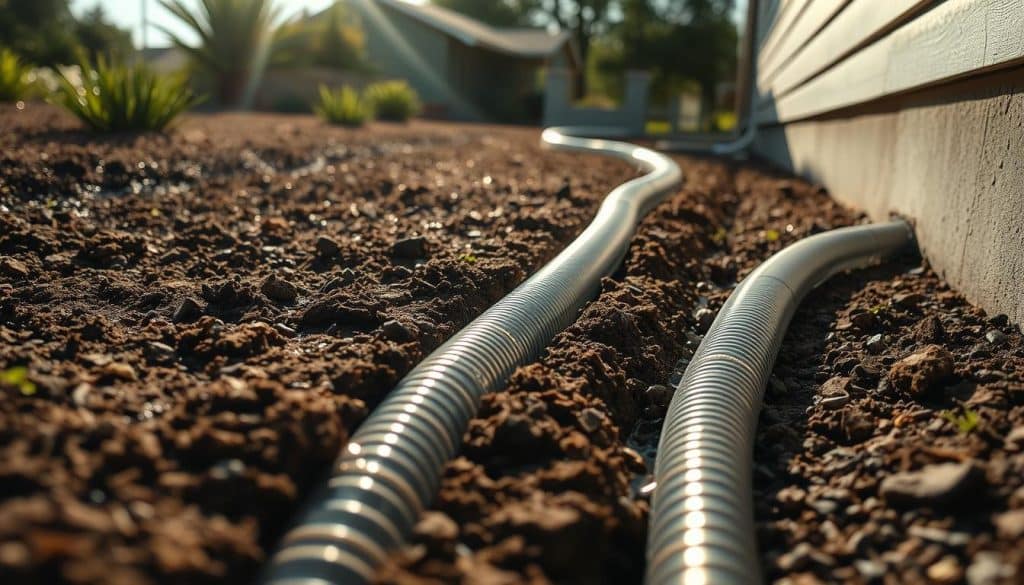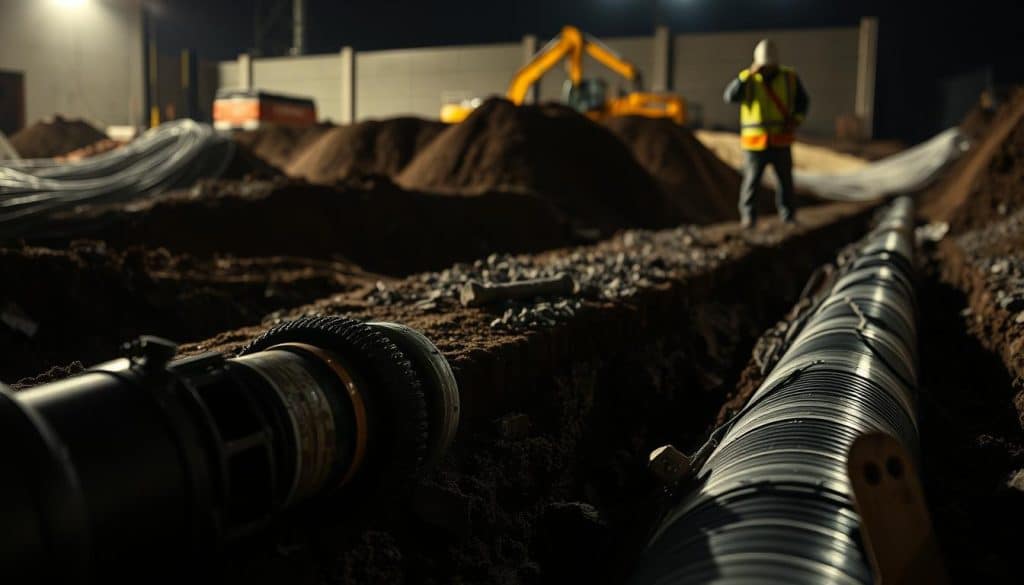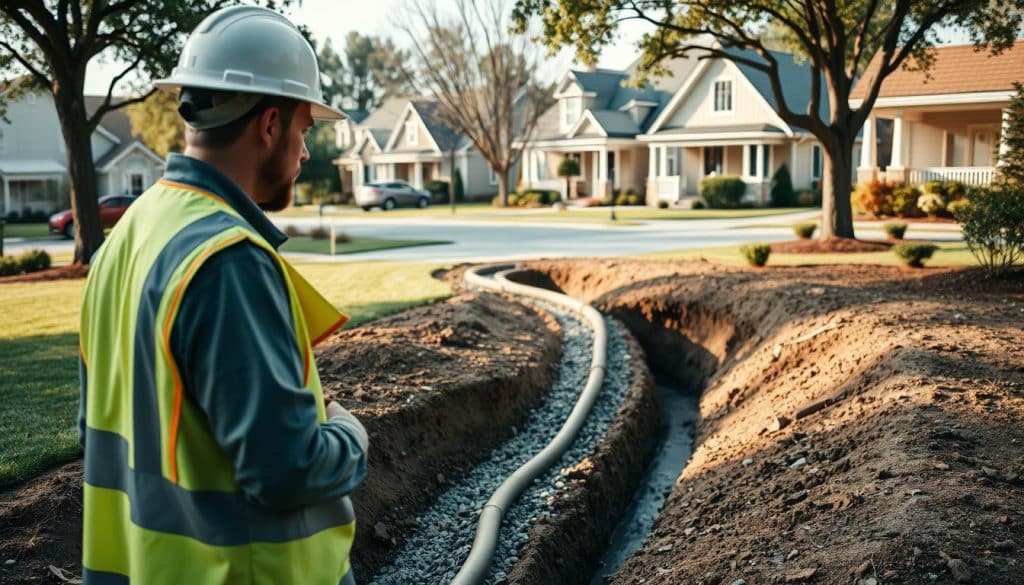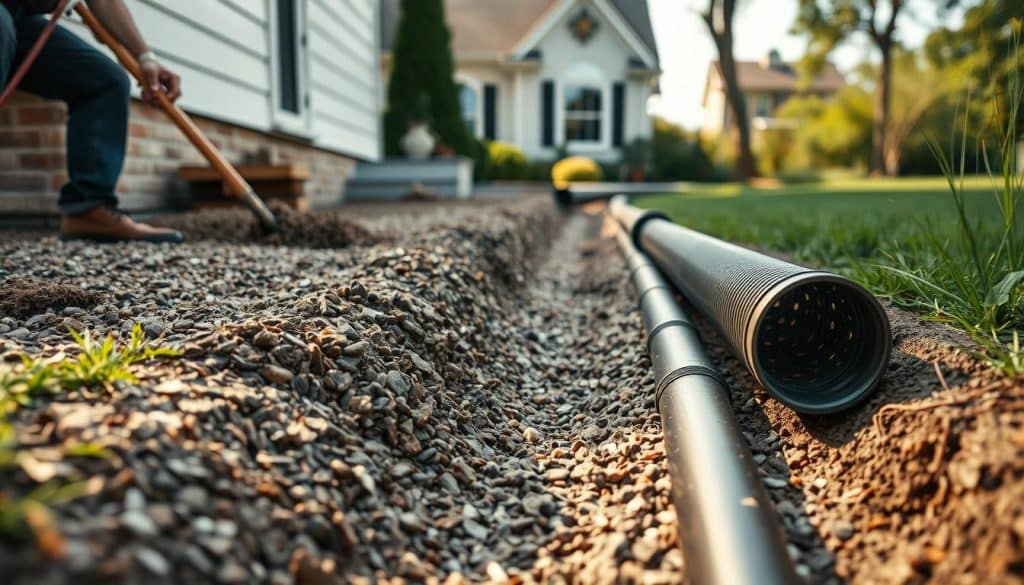Table of Contents
Ever thought about doing a DIY French drain to save on basement waterproofing? Can I Install a French Drain Myself? It might seem simple to dig a trench and set up a drainage system. But, many homeowners don’t realize how complex this task can be.
Installing a French drain yourself could save money, but you need to know your property well, follow local rules, and follow each step carefully. We’ll look into if you can do this on your own and what you need to know for a good job.
Key Takeaways
- Installing a French drain yourself can be a cost-effective alternative.
- Understanding local regulations is key before starting.
- Proper planning and knowing your property well are vital for good drainage.
- Mistakes during installation can cause expensive fixes later.
- Think about getting help from pros if you’re unsure about anything.
- Keeping your French drain system in good shape is important for its long life.
Understanding French Drains
A French drain is key in managing water, helping with surface water drainage in homes and businesses. It’s a trench filled with gravel or rock and a perforated pipe. This pipe captures excess water and moves it away from flooding or damp areas. Henry French first described these systems, and they’ve evolved to protect properties from water damage.
What is a French Drain?
The French drain is made to move surface and groundwater away from important areas like foundations and basements. It uses gravity to guide water to drainage basins or low spots. This helps prevent water pressure damage and keeps structures stable.
How Does a French Drain Work?
A French drain works by collecting rainwater in a trench and moving it into a drainpipe. The water flows through the pipe’s holes and is carried away from the property. It’s important to install it correctly and ensure the pipe slopes at least 1% for good flow.
Keeping the French drain in good shape is vital. This means using the right filters and checking it regularly. This ensures it continues to work well and protect your property.
Benefits of Installing a French Drain
Installing a French drain is a smart move for homeowners. It helps prevent water damage and protects foundations, basements, and outdoor spaces. This can save you from expensive repairs, which can cost between $2,000 to $7,000.
Preventing Water Damage
French drains are great at keeping water away from sensitive areas. They help prevent flooding and water buildup around your property. This keeps your home’s structure safe and saves you money on repairs.

Reducing Mold Growth
Keeping your home dry is key to avoiding mold. French drains help manage excess water, reducing mold in basements and other areas. This improves your air quality and keeps you safe from mold-related health issues.
Improving Property Value
Adding a French drain can make your home more attractive and safe. It shows you care about your property and can increase its value. Homebuyers often look for homes with good water management systems, making this a smart investment.
Assessing Your Property’s Needs
Before starting a French drain installation, it’s key to understand your property’s needs. You need to spot water issues and study drainage patterns in your yard. Knowing your property’s challenges helps plan a good drainage solution.
Identifying Water Issues
First, find out where water problems are. Look for spots that get waterlogged after rain or flood often. Watching how water moves in your yard helps figure out what you need.
Make a note of water pooling, mainly in low spots or near your home’s base. This info helps place the French drain right for best water flow.
Analyzing Drainage Patterns
Then, look at how water moves on your property. See where rainwater goes and how fast it drains. This is important for the French drain’s path.
Also, consider any plumbing or underground utilities. They might affect where you can put the drain. By studying these patterns, you can manage water better and avoid future problems.
Tools and Materials Required
Starting a DIY French drain project means you need the right tools and materials. Knowing what you need will make the job easier and more effective.
Essential Tools
Having the right tools is key to a smooth French drain installation. You’ll need a shovel and a trench digger to dig the trench, which should be 12-18 inches deep. A level is important to make sure the trench slopes correctly for good drainage.
Wearing safety gear like gloves and eye protection is a must. You might also need a compacting tool to pack the gravel well.
Necessary Materials
The materials needed for a French drain are critical. You’ll need perforated pipe to collect and move groundwater. Landscape fabric helps keep debris out of the system.
Gravel is used as a base and to filter out particles. A 2-3 inch layer at the bottom and 5-10 cm on top is recommended. For areas with lots of rain or below the water table, you might need drain boxes or sump pumps.
Knowing the cost of these materials is important. DIY projects usually cost between $10 to $20 per linear foot. This helps with planning your budget.
Steps to Install a French Drain
Installing a French drain needs careful steps. First, plan the drain path well to manage water effectively. Start by picking the best route, making sure it slopes down at least 1%.
With a plan, dig trenches that fit the recommended size for good drainage.
Planning the Drain Path
Planning the drain path is key to a successful French drain. Choose a spot that keeps rainwater away from buildings. Mark the path, aiming for a 1% slope, or one inch drop for every ten feet.
This careful planning helps ensure water flows right through the system.
Digging the Trench
Digging trenches is hard work but essential. Aim for a trench 18 inches deep and 12 inches wide. This size helps water drain well and fits the components right.
Use a trenching machine, which costs about $100 to $200 a day, to speed up digging. Always call 811 to check for underground lines before digging.
Laying the Pipe
Next, lay the perforated pipe in the trench. Start with three inches of gravel as a base. Put the pipe in with holes facing down to catch water.
Ensure the pipe is sloped right and goes from start to end of your drainage area. Use 4-inch HDPE pipes for homes.
Covering the Drain
After laying the pipe, cover it up. Use more gravel, 3/4 to 1 inch in size, to help water drain and soak into the ground. Wrap the system in filter fabric to stop clogs from soil.
Lastly, cover the area with soil or landscaping to make your yard look natural again.
Common Mistakes to Avoid
When you’re installing a French drain, knowing common mistakes is key. Many homeowners miss important details that lead to drainage problems. These issues can make water problems worse over time.
Poor Drain Placement
Choosing the right spot for the drain is critical. If placed wrong, water might flow towards your home instead of away. A well-designed drain keeps water from your foundation, preventing damage. Without understanding your property’s water patterns, you might make problems worse.
Inadequate Backfill
Proper backfilling after installation is essential. Bad backfill can cause the drain to settle or collapse. Use the right materials and compact the soil well. Poor backfilling can lead to long-term drainage issues that are hard to fix.
Not Considering Local Regulations
Ignoring local rules can cause big problems. Always check zoning laws and follow local codes. This way, you avoid costly changes and ensure a smooth installation that meets all regulations.

Maintaining Your French Drain
After installing a French drain, it’s important to take care of it. Regular checks and cleaning are key to keeping it working well. These steps help stop blockages and make sure water flows away from your home.
Regular Inspections
Regular checks on your French drain help spot problems early. Look for clogs and make sure the drainage outlet is clear. Watching it after heavy rain shows how well it works and if you need to act fast. Doing these inspections often keeps your drain in top shape.
Cleaning and Clearing Debris
Cleaning your drain is essential to stop debris from blocking it. You should clean it at least once a year. An electric sewer snake is great for getting rid of clogs in hard-to-reach places. Keeping an eye on your French drain helps it work right and protects your home from water damage.
When to Call a Professional
Knowing when to hire professionals for drainage solutions is key for homeowners. Many drainage problems seem easy at first but need expert help. Issues like very wet or sloped land often require more than DIY can handle.
Complex Drainage Issues
Some drainage problems are complex, like bad grading or old gutters. If DIY fixes don’t work, it’s time to call a pro. Experts can handle these tough cases and avoid safety risks.
They know how to install a French drain right. This includes making sure it slopes at 1% to move water away.
Local Regulations Compliance
Following local rules is also important for drainage projects. Pros know these rules well and can deal with permits and inspections. This is helpful when dealing with sewer issues or local water companies.
Choosing a skilled contractor means your project will meet all standards. This avoids fines or penalties.
Array of Solutions: Our Expertise
At Array of Solutions, we tackle your moisture worries with expert services. For over 15 years, we’ve been keeping homes in Spartanburg safe and healthy. Our team uses the latest tech to spot mold problems and offer solutions that fit your needs.
Certified Mold Inspection Services
Our certified pros know mold inspection inside out. They stress the need for early detection and prevention. They do detailed checks to find moisture issues, ensuring quick and effective services. With over a decade of experience, Array of Solutions gives you peace of mind for a safe home.
Personalized and Affordable Solutions
We offer custom solutions for each client’s needs. Whether it’s fixing drainage or stopping mold, our methods are both effective and budget-friendly. Regular checks and upkeep can save you from expensive fixes, keeping your property safe for years.
Customer Testimonials
Our clients’ stories show the quality of our services at Array of Solutions. They talk about how our drainage solutions stop mold and water damage. Many homeowners are happy with the results, thanks to our hard work.
Success Stories from the Community
Our community has many success stories. People say our French drain installations have changed their homes. They’re happy with the water management, like in basements where water used to be a problem.
For example, one homeowner is thrilled with a 40-foot French drain. It solved their flooding issues. This shows why choosing quality service for drainage is important.
Understanding Our Client Satisfaction
Happy clients are key to our business. We get feedback that shows our success comes from understanding each property’s needs. Our detailed guide helps us do this.
We also follow local rules to make our clients’ experience better. Working closely with our clients helps us get better at solving their drainage problems. This shows how teamwork and talking openly are vital.
Contact Us
If you’re dealing with mold or need help with water drainage, Array of Solutions is here for you. Our team offers expert services tailored to your needs. We handle everything from small mold spots to big water drainage problems.
Get in Touch for Mold-related Services
To reach us, call (864) 710-6413 or email scmoldremoval@gmail.com. We’re a local company in Greenville, SC, serving South Carolina. We’re committed to excellent customer service and quick, effective solutions.
How to Reach Array of Solutions
Need mold testing or drainage help? Our team is ready to help. We ensure your space stays safe and healthy. Contact us today for top-notch service.


